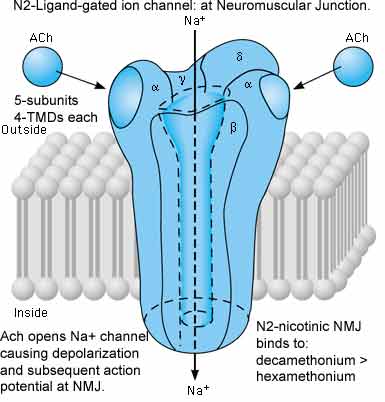Nicotinic receptors are of two types as
- NM Receptors
- NN Receptors
These receptors, along with the muscarinic receptors, are called cholinergic receptors as the neurotransmitter acetylcholinesterase and butyrylcholinesterase specifically stimulate them.
However, the alkaloid nicotine is the only external substance that can specifically stimulate them. Hence they are named nicotinic receptors.
They are specifically blocked by the alkaloid D-tubocurarine (arrow poison).
Structurally they are ligand-gated ion channel receptors.
Due to having ligand-gated channels, the response to the ligand is very quick. The response time is in a fraction of a second or microseconds.
So they are located in places where such high-speed responses are required.
These receptors are of two types as
Types of Nicotinic Receptors
Nicotinic receptors are basically of two types like
- NM Receptors
- NN Receptors
They are classified so based on their location in the body.
NM is present in the neuromuscular junction or skeletal muscle endplate.
NN is present in the neuronal ganglia and synapses.

NM Receptors
These are stimulated by phenyl trimethylammonium and blocked by D-tubocurarine.
Function: NM Receptors transmit signals for skeletal muscle contraction.
NN Receptors
These receptors are present in the ganglion of both the sympathetic and parasympathetic nervous systems. Besides, they are also present in the brain, spinal cord, and adrenal medulla.
They are stimulated specifically by phenypiperanzinium and blocked by hexamethonium. Their main function is the transmission of nerve signals at the ganglion.
Function:
- They stimulate both sympathetic and parasympathetic ganglia and process post-ganglion impulses.
- Stimulate the release of adrenalin from the adrenal medulla
- Involved in excitation and inhibition of CNS (site specifically).
In the lab, the rabbit head drop method can demonstrate nicotinic receptors’ actions.
Wherein the rabbit, when given an injection of D-tubocurarine (DTC) will be unable to hold its head erect. It just hangs until the effect of DTC is exhausted.
In the forest, large animals and elephants could be arrested using an arrow stained with DTC. The elephant’s skeletal muscles get paralyzed for a while and hence will be unable to move. This helps them to be captured by hunters.
Difference between nicotinic and muscarinic receptors
| Character | Nicotinic receptor | Muscarinic receptor |
|---|---|---|
| Types | Just two types as NM and NN | Five types as M1, M2, M3, M4 and M5 |
| Mechanism | Voltage-gated Ion channel | G protein-coupled (GPCR) |
| Agonist | Stimulated by nicotine and acetylcholine | Stimulated by muscarine besides acetylcholine |
| Antagonist | D-Tubocurarine | Many like atropine, pirenzepine, gallamine, Ipratropium. |
| Response | In a fraction of second | A bit longer, like in a few seconds |
| Distribution | Only in the ganglia and neuromuscular Junction. | In many organs like the heart, lungs, salivary glands, stomach, intestine, etc. |
| Role | In nerve conduction and contraction of skeletal muscles. | Many roles, as it is part of the parasympathetic function. |